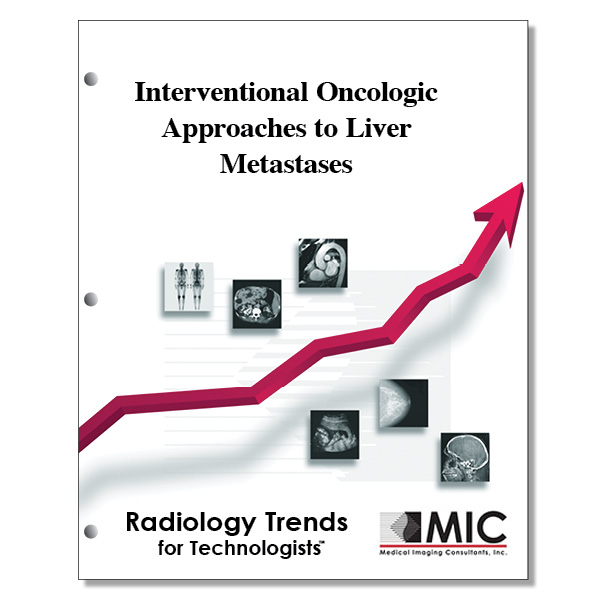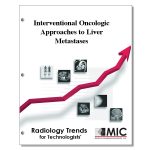

Interventional Oncologic Approaches to Liver Metastases
The rationale, application, and clinical results are reviewed of interventional oncologic techniques developed to treat secondary liver malignancies.
Course ID: Q00380 Category: Radiology Trends for Technologists Modalities: Radiation Therapy, Vascular Interventional5.25 |
Satisfaction Guarantee |
$39.00
- Targeted CE
- Outline
- Objectives
Targeted CE per ARRT’s Discipline, Category, and Subcategory classification:
[Note: Discipline-specific Targeted CE credits may be less than the total Category A credits approved for this course.]
Registered Radiologist Assistant: 5.25
Procedures: 5.25
Abdominal Section: 5.25
Radiation Therapy: 3.75
Patient Care: 2.00
Patient and Medical Record Management: 2.00
Procedures: 1.75
Treatment Sites and Tumors: 1.75
Vascular-Interventional Radiography: 5.25
Procedures: 5.25
Vascular Interventional Procedures: 4.00
Nonvascular Procedures: 1.25
Outline
- Introduction
- Overview of PVE
- Technique
- Indications and Results
- Overview of HAIC
- Technique
- Indications and Results
- Percutaneous Ablation Techniques
- Rationale
- RF Ablation
- Microwave Ablation
- Indications and Results of Thermal Ablation in Metastatic Liver Disease
- Transarterial Embolization Techniques in Hepatic Metastases
- Indications
- Technical Considerations in Chemoembolization
- Clinical Results of Chemoembolization
- Radioembolization of Liver Metastases
- Rationale for 90Y Radioembolization
- Technical Considerations in Radioembolization
- Clinical Results of Radioembolization in Liver Metastases
- Toxicity and Complications in Transarterial Embolization Techniques
- Techniques Under Development
- Conclusion
Objectives
Upon completion of this course, students will:
- understand the number of patients that will die due to metastatic liver disease from colorectal liver metastases
- communicate what treatment provides the best long term survival rate in patients with colorectal metastatic disease
- explain the percentage of patients who are candidates for surgery to treat colorectal metastatic cancer
- indicate what percentage of metastatic lesions in colorectal cancer patients will be completely sterilized by chemotherapy
- identify a limit to liver resection
- recognize the most feared post-operative complication after hepatectomy
- understand what vessels are targeted during portal vein embolization
- visualize portogram images at all stages of portal vein embolization procedures
- explain which approach to the portal venous system may damage future remnant liver
- understand the most frequently reported embolic materials used for portal vein embolization
- communicate what area of the liver is most commonly targeted for PVE
- indicate the percentage of future remnant liver volume patients must have to be considered for portal vein embolization
- discuss what liver condition will produce better portal vein embolization outcomes
- understand how liver metastases receive blood supply
- indicate the percentage of FUDR extraction in the liver that occurs during hepatic artery infusion chemotherapy
- explain why permanent access to a hepatic artery is necessary for hepatic artery infusion chemotherapy
- identify the routes for catheter placement into the hepatic artery
- understand when hepatic artery infusion chemotherapy is utilized
- communicate the most common side effects of FUDR used in hepatic artery infusion chemotherapy
- indicate the benefits to hepatic artery infusion chemotherapy
- be aware of multiple percutaneous ablation techniques
- communicate the intent of ablation therapy
- understand the three phenomena that define the results of hyperthermal ablation
- identify the limitations to surgical resection of liver metastases
- indicate what therapy utilizes direct injection of pure alcohol into cancer cells
- discuss methods used to perform microwave ablation therapy
- understand the technical advantage of microwave therapy over radiofrequency therapy
- be aware of the advantages of thermal ablation over resection
- explain what size metastatic liver tumors respond best to thermal ablation therapy
- discuss the advantages of intraoperative radiofrequency ablation
- recognize the survival rate for patients receiving thermal ablation of liver metastases caused from neuroendocrine tumors
- state the two types of transarterial embolization
- explain the Eastern Cooperative Oncology Group scoring system
- describe the ECOG status of 2 required for transarterial treatment
- list the indications for radioembolization in colorectal metastases to the liver
- understand pre-treatments required for chemoembolization patients
- describe the type of diagnostic angiography necessary for chemoembolization patients
- list the most commonly used chemotherapeutic agents
- describe the types of metastases for which chemoembolization has been utilized
- indicate what percent of the population receiving chemoembolization will experience major complications
- understand why care must be taken when advancing catheters during chemoembolization procedures
- understand the rare, non-vascular complications associated with chemoembolization
- identify the two materials used in radioactive microspheres
- select which commercially available 90Y particles are comprised of glass or resin
- communicate the three qualifications for radioembolization
- discuss the importance of pre-radioembolization angiography
- summarize studies on radioembolization of liver metastases from NET, breast cancer, and uveal melanoma
- communicate the difference in toxicity levels between radioembolization and chemoembolization
- state the more serious complications involved with radioembolization
- recognize the new techniques under development for cancer treatment
